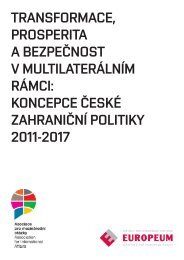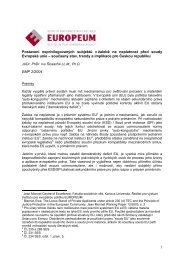eu constitutionalisation - EUROPEUM Institute for European Policy
eu constitutionalisation - EUROPEUM Institute for European Policy
eu constitutionalisation - EUROPEUM Institute for European Policy
Create successful ePaper yourself
Turn your PDF publications into a flip-book with our unique Google optimized e-Paper software.
Chapter 4: Government Coalitions and Institutional Re<strong>for</strong>m at the IGCrecently-gained sovereignty.¹⁰⁶ Benelux states were especially doubtful, ¹⁰⁷whereas Austria, Finland and Portugal, despite doubts, found it strategicallyimportant to maintain the coalition of small states. Benelux believedthat it would be strategically very damaging <strong>for</strong> the group’s influence inthe Convention if a substantive number of members of the group were toshift sides during the Convention.¹⁰⁸ Most of the members of the groupof ‘Friends’, especially the accession states, held it against Benelux to havechosen to stay outside ‘Friends’, believing that this strategy was damagingto the interests of the small states.¹⁰⁹Whereas the Benelux coalition was preserved throughout the Convention, itstarted loosening during the IGC. On most of the institutional issues they stillagreed – including to jointly change the position on the rotating Presidencyand accepting the elected President of the <strong>European</strong> Council (CIG 53/0324 November 2003) – but the IGC opened the issue of the use of QMV onwhich the three countries had considerably divergent views. While Belgiumwished <strong>for</strong> as much extension as possible, Luxembourg was wary of taxharmonization and social and migration policies. The Netherlands had reservationsabout extensions to budget negotiations which were also favouredby Belgium. Hence, their partnership loosened, partly due to the divergentinterests, and partly due to the Presidency’s strategy of negotiating with thestates individually and trying to break-up coalitions, .In conclusion, the Benelux states are a strategic coalition brought togetherthrough cultural affinity and shared views regarding the future of the EU. Inthe examined negotiations, they have stayed together also <strong>for</strong> power considerationseven though their interests were divergent on many issues.Friends of the Community MethodDuring the Convention the small countries established the so-called‘Friends of the Community Method’ group which focused especially onthe debate concerning the institutional provisions. The group could be seenas a <strong>for</strong>malisation of the small states’ cooperation during the Amsterdam106) Ibid.107) Ibid.108) Ibid.109) Confidential interviews with government officials from Austria in Vienna on 15 October 2004, Estonia inBrussels on 17 September 2004, Czech Republic in Brussels on 17 September 2004.132Chapter 4: Government Coalitions and Institutional Re<strong>for</strong>m at the IGCand, especially, the Nice Treaty negotiations. In Nice, the then ten smallstates – Benelux, Austria, Denmark, Greece, Ireland, Portugal, Swedenand Finland – gathered around the position of retaining the rule of onecommissioner per member state.¹¹⁰ This was clearly the key issue whichheld the group together. While countries like Ireland, Portugal, Greece,Austria and Finland also agreed on many other institutional issues, themore EU sceptic Denmark and Sweden tended to be rather ambivalentabout allegiance.¹¹¹ The group, although stressing its in<strong>for</strong>mal character,has, however, displayed a high level of coordination in terms of meetingsand joint strategy <strong>for</strong> work in the Convention and press conferences. In thefirst three months until December 2002, the small states from the existingmember states including Benelux met frequently to discuss their positionsand possible coordinated action in the Convention.In the December 2003, the Benelux countries presented their own institutionalproposal to the rest of the group of ‘Friends’.¹¹² During the meetingit became evident that there was divergence in the views regarding thecomposition of the <strong>European</strong> Commission <strong>for</strong> which Benelux were willingto accept the Nice arrangement and the rest of the group argued <strong>for</strong> returnto the rule one Commissioner per member state.¹¹³ At the same meeting,a decision was taken that the accession states would be invited to join thegroup.¹¹⁴ By February, all new accession states were included in the group.By that time, the leadership of the group was clearly in the hands of theAustrian, Greek, Finnish, Irish and Portuguese representatives. The Beneluxstates indicated that they were happy to participate with the group onshared interests, but would not <strong>for</strong>mally be part of the group.¹¹⁵According to Austrian government representative Birklbauer, ‘the real booster<strong>for</strong> the coalition of like-minded and its ambition to <strong>for</strong>ward a commoninstitutional paper was […] – besides the Praesidium’s refusal to establish110) Confidential interviews with government officials from Austria in Vienna on 15 October 2004 anda Belgian government official in Brussels on 17 September 2004.111) Ibid.112) Birklbauer (2004).113) Ibid.: 162. There was, however, an indication that within the Benelux, Luxembourg was more inclinedtowards retaining one Commissioner per member state rule. This was evident much later when on 12June 2003 at the end of the Convention Luxembourg co-signed the ‘Friends’ proposal which includedinsistence on this particular rule.114) Ibid.115) Confidential interview with a government representative from Portugal in Brussels in September 2004,and from Belgium in September in Brussels 2004.133








